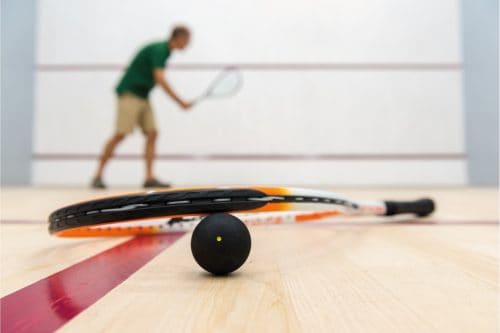The strings on a tennis racket are one of the most important pieces of equipment for any tennis player. After all, the strength and tension provided by tennis strings are what help send the tennis ball across the net toward the opponent. Thus, it's important to ensure that this equipment is in good working order. So, do tennis strings ever go bad or expire? We did the research to bring you the answer.
Tennis strings don't expire per se, but they do eventually go bad. Over time, they lose their tension and strength from use and sun exposure.
If you still have some more questions about the life expectancy of tennis strings, don't worry. In this guide, we'll discuss the topic at length, and we'll answer some additional questions you might have. Without further ado, let's get into it!

Life Expectancy Of Tennis Strings
The longevity of tennis strings depends entirely on how often they are used and the elements they are subjected to. Depending on these factors, tennis strings can last anywhere from a few weeks to several years; in fact, some people have reported that their tennis strings lasted for more than a decade!
As mentioned, tennis strings don't necessarily have a set shelf life; the frequency at which they should be changed largely depends on use. For instance, professional tennis players that play constantly typically restring their rackets daily or every few days since tennis strings quickly lose tension and resilience with heavy use. On the other hand, if a racket simply hangs in the garage and is seldom used, the strings will likely remain good for months or even years, depending on the environmental conditions.
And as mentioned, sun exposure can significantly shorten the lifespan of tennis strings. If a racket is left out in the sun while it isn't being used, the life expectancy of the strings will quickly dwindle. Simply keeping your racket out of the sun while it isn't being used will prolong the life of the strings.
In the end, the lifespan of your tennis strings is directly correlated to the frequency with which they are used and exposed to the elements. If you play often, expect to restring your racket more often. If you don't play much, you shouldn't have to restring your racket often.
How Do You Know When Your Tennis Racket Needs To Be Restrung?
At this point, you might be wondering how to tell when your racket needs new strings. Here we'll give you some practical ways to determine whether or not your tennis racket should be restrung.
1. Visually Inspect The Strings
One of the quickest and easiest ways to determine whether or not your tennis racket needs to be restrung is to visually inspect the strings for damage. If the strings are visibly worn and frayed, they should be replaced; this is a clear indicator that your tennis strings are no longer serviceable.
2. Evaluate The Performance Of The Racket
If your tennis strings don't show any visual signs of deterioration, take your racket onto the court and simply play for a bit. If you feel like you have to hit the ball harder than usual, the likely culprit is bad strings. As tennis strings lose tension, the racket becomes less efficient; since the strings are lacking tension, more strength is needed to hit the ball.
3. Consider The Frequency Of Use
And last but certainly not least, a good rule of thumb to follow is to restring your racket as many times in a year as you play per week. So, if you play tennis once a week, you only need to restring your racket once a year. On the other hand, if you play five times a week, you should restring your racket approximately five times a year.
This is by no means a hard and fast rule but rather a general guideline to follow for the best results and optimal performance. If your racket's performance remains the same and if your strings show no sign of wear, follow this rule of thumb for the best results.
How Much Tension Do Tennis Strings Lose?
There are three main types of tennis strings: gut, nylon, and polyester. Strings made of each material lose different amounts of tension with use; gut strings retain the most tension, polyester strings lose tension the fastest, and nylon strings fall in the middle.
A study conducted by Tennis Warehouse University revealed that tennis strings made of each material can lose up to one pound of tension per hit, but they eventually reach a point of stabilized degradation. In other words, freshly strung rackets will lose a significant amount of tension right off the bat, but this tension loss levels out and becomes more gradual.
Why Do My Tennis Strings Keep Breaking?
If you find that your tennis strings break constantly, there's likely one culprit: spin. That's right, the spin you put on the ball can significantly wear on the strings, causing them to break.

At this point, you're probably wondering what you can do to prevent this from happening. In reality, the only solution is to change your playing style, which isn't recommended, especially if your playing style has been successful.
Thus, the best thing to do is to simply drive on and accept the fact that many broken strings are in your future. If you play competitively, bring an extra racket or two to each match.
Do Tennis Strings Make A Difference?
The type of tennis strings you use can certainly make a difference. As mentioned, depending on the material, some strings are more resilient than others. In addition, tennis strings come in a variety of gauges, or thicknesses, and each gauge will have a slightly different impact on your game. The bottom line is that the string you use will indeed have a noticeable effect on your game.
For your convenience, we created a list of some of the best tennis strings on the market. Check them out:
Solinco Hyper-G High Spin String
This tennis string has a unique square profile for improved contact with the ball and superior performance. The pack includes 40 feet of string, and you can select from a number of gauge options.
Click here to see this product on Amazon.
Wilson Synthetic Gut Power String
Wilson Gut Power string has a reputation for strength, durability, and power. It has a solid nylon core with a high energy wrap for superior performance on the court. This string comes in either lime green or pink, so you can choose the color that best suits you. This pack contains 40 feet of string.
Click here to see this product on Amazon.
Luxilion ALU Power String
This 16 gauge tennis string is made of sturdy co-polymer fluorocarbon resin fibers for superior resiliency. In fact, this type of string is used by a significant amount of professional tennis players. This pack comes with 40 feet of string.
Click here to see this product on Amazon.
In Closing
We hope this guide has helped you better understand the life expectancy of tennis strings and the maintenance required to keep your tennis racket in proper working order. At the end of the day, you can't restring your racket too often. Before you go, be sure to check out these other guides that might be of interest:






![Read more about the article How To Build A Concrete Basketball Court? [5 Steps]](https://fitseer.com/wp-content/uploads/2020/10/Concrete-basketball-court-in-the-backyard-of-a-home-500x333.jpg)


